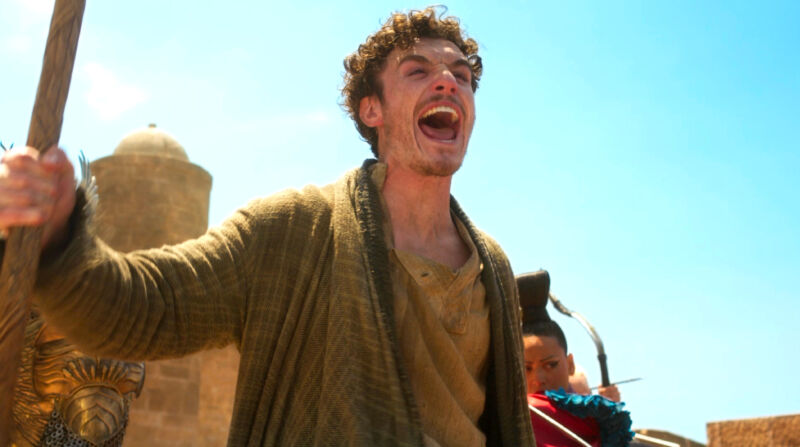
Andrew Cunningham and Lee Hutchinson have spent decades of their lives with Robert Jordan and Brandon Sanderson's Wheel of Time books, and they previously brought that knowledge to bear as they recapped each first season episode of Amazon's new WoT TV series. Now they're doing it again for season two—along with insights, jokes, and the occasional wild theory. These recaps won't cover every element of every episode, but they will contain major spoilers for the show and the book series. We're going to do our best to not spoil major future events from the books, but there's always the danger that something might slip out. If you want to stay completely unspoiled and haven't read the books, these recaps aren't for you.
New episodes of The Wheel of Time season two will be posted for Amazon Prime subscribers every Friday. This write-up covers episode eight, the season finale, which was released on October 6.
I found this year's finale more followable and satisfying than last year's, though I suspect it may be a breaking point for people who are earnestly upset about how different the show is from the works that are being adapted. Most of the episode is actually focused on Ishamael, our main Forsaken—we get a short Age of Legends prologue where he tries to convince former friend and original Dragon Lews Therin Telamon to help him break the Wheel and end the continuous cycle of birth and death and rebirth. He's still after that goal thousands of years later, and this episode explains a bit more about what he's been doing all season and why.
We're shown this scene for a few reasons, but I think one of them is to emphasize that the Forsaken were all sealed away in individual prisons, which take the form of giant disks of unbreakable Cuendillar. This is definitely a different tack than the books, but it definitely simplifies things. I did find it a little weird that Ishamael had all six of the remaining seals propped up in his room, like he was hanging out with them or something—but I guess "weird" doesn't really apply when we're talking about the behavior of millennia-dead superhuman wizard people.
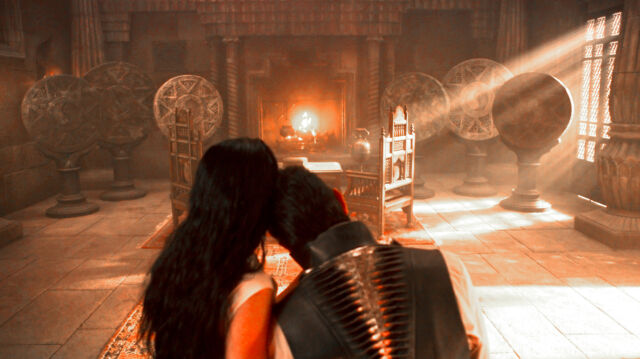
Having eight Forsaken instead of 13 (plus various reincarnated clones, territory the show may or may not decide to cover) is part of the show's modus operandi for making Jordan's world more manageable. How many scary villains do we really need running around at once, especially when quite a few of them are basically just Generic Bad Guys? Why does Rand need a pair of unhealable holes in his gut, when one hole that has properties of both will do?
Based on how Mat's arc this season wraps up, it also seems pretty likely that we end up skipping or condensing at least some of the Rhuidean-Aiel-testing-ground stuff from book four. All of these tweaks have major narrative implications, but so many of these things pay off so far down the line in the book version of the story that it's simply not possible to guess how the show might handle them. The show doesn't seem to feel like it "needs" to hit any given plot point from the books—sometimes, as in one scene this episode, it seems to relish subverting book readers' expectations. And while I'm having fun with the show's increasingly unique riff on this story, I can see why people hoping for "an adaptation of The Wheel of Time" might be frustrated with it.
Right, so, this episode brings us to kind of the fruition of Lanfear's plan, to the detriment of poor Ishamael. Ishy has—had!—a formal plan to bind the Dragon and his ta'veren friends. It involved moving them around on the chessboard of Randland, manipulating them into falling into the shadow, and then getting Rand to choose darkness to save them. (This also puts some more context around Mat's tea-driven vision quest last episode.)
Lanfear gives no effs. Lanfear's like a honey badger, and Lews Therin Telamon is the honey. She cares about Ishamael's plan only inasmuch as it gives her the opportunity to force Rand to proclaim himself, embrace his destiny, recall his past lives, fall back in love with her, and live evilly ever after. Anything else can burn.
You'd mentioned previously that the Forsaken often work at cross-purposes, and hoo boy, were they ever here. Classic Lanfear.
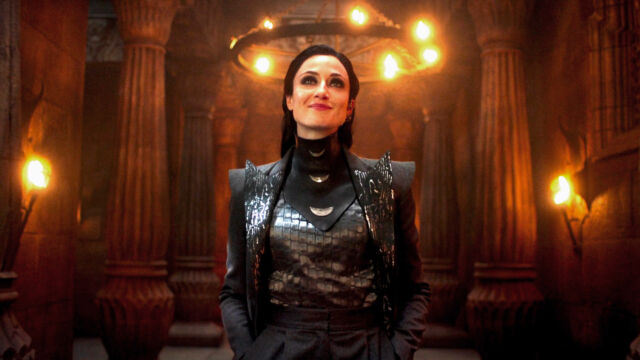
Anyway.
From Moghedien, one gets the sense that the other Forsaken don't like Lanfear much, because they (completely understandably and justifiably!) think she's just a bit too close to the goody-goody Dragon to be trustworthy. The show has gotten a lot of mileage out of Lanfear-as-frenemy this season, and it seems like we can expect that to continue for at least a while longer.
Early in the episode, Lanfear puts the "enemy" in "frenemy" by separating Moiraine and Lan from Rand in the Ways, dumping them out on a beach some distance from Falme so that they can't get directly involved in most of the fighting. This also gives the two of them the space to Talk It Out, re-forming the Warder bond Moiraine broke at the beginning of the season (still fuzzy on the mechanics of that) and rededicating themselves to the support of the Dragon Reborn. What's everyone else doing?
Everyone else is running around in Falme, and the Whitecloaks show up and kick off the giant battle. Geofram Bornhald (Stuart Graham) isn't necessarily a bad fellow—as he points out, the Children of the Light are in Falme to save people from the Seanchan invaders, and they proceed along that track with alacrity. But Bornhald is the classic Paladin archetype—he and his Children are incapable of bending the rules. See evil, must kill. And "evil" is whatever they say it is.
Aviendha, Bain, and Chiad roll up with Perrin and Hopper in tow, so they get added into the mix of battle. After that, we variously get a bunch of happy (if rushed) reunions between our prime characters, some of whom haven't seen each other in months. The episode is an absolute symphony of reunions, all over the place.
One of those reunions is Mat and village peddler/ultra-darkfriend Padan Fain—and, hey, there's the Shadar Logoth dagger! I don't think Mat is aware that Fain is a darkfriend at first, but him showing up and producing the dagger probably goes a long way to getting that message across.
And then, Mat makes a…well, it's not exactly an ashandarei, but it is kind of a, like, knifey-stick. And it cuts through things like a lightsaber! Does he keep it? Does he trade it in? … is it time to talk about Mat? There's so much Mat to talk about.
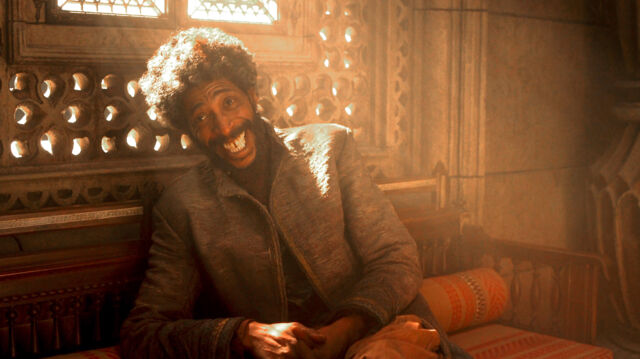
In terms of the Mat storyline, the character currently seems to be somewhere toward the middle of book four as far as his development goes. He has found and blown the Horn of Valere, which (as in the books) summons a bunch of dead heroes to fight alongside the blower. But for Mat, it also seems to give him the memory of his past lives that Ishamael's weird tea promised last episode. So he kind of has his Signature Weapon, and he has picked up most of his character's Signature Traits. It's just Not The Way It Is In The Books.
You seem to have more Mat feelings you want to dig into, how are you feeling about all of this?
Though before I go on about Mat, I want to gush just a moment about seeing Guy Roberts back as Uno, who apparently kicked so much ass in life that upon death he was instantly upgraded to Hero of the Horn. Given that Guy Roberts is a self-professed fan who first read the series in the ‘90s, it gave me a lot of joy to see him get to inhabit the role of Uno with such obvious scene-stealing relish, and to know that he's living the actor's dream of bringing to life a character that he loves.
Artur Hawkwing (Adrian Bouchet) delivers some lines to Mat that he originally delivered to Rand in the book, which—well, I suppose it's all part of the new path the showrunners have put Mat on. The destination is getting a little clearer, but I'm still wondering if he's going to keep his knifey-stick, or if it's going to get upgraded at one point—after all, fully separating him from the dagger and its influence is a major deal in the first few books, and keeping it will have consequences.
We have our first on-screen utterance of Mat's "it's time to toss the dice" in the Old Tongue, and it's great. Show-Mat deserves it. After two seasons of grim purposelessness, he's finally given something good—and it's so good.
The Sounding of the Horn leaves book readers with more questions about Mat than answers—but my guess is these are questions that will be tackled in the front half of the next season. For non-readers, leading the charge of the Heroes of the Horn is a wonderful bow to tie around his two-season journey through crap. Hell, if I have a complaint about Mat's sounding of the Horn, it's that budget and cost of production necessarily limits what should be a Helms Deep-scale routing of the bad guys by a horde of legendary warriors whose deeds have elevated them to immortal demigod status.
Whew, okay. Any more Mat feelings from you?
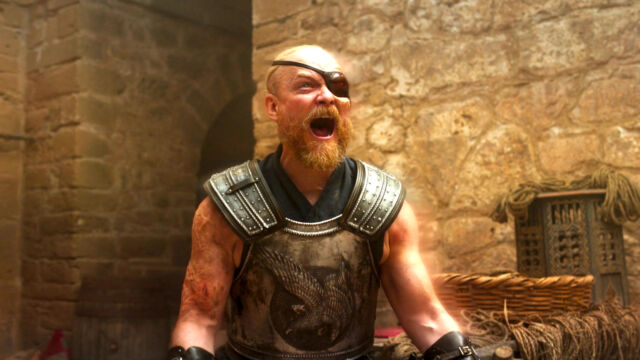
Egwene's capture and torment by the Seanchan is transformational for her in the books as in the show—it massively increases her strength and aptitude with the One Power, and it gives her a deep hatred of the Seanchan and everything about them. That hatred occasionally gets a little dark, as it does when Egwene collars, briefly torments, and then kills her sul'dam, making good on her promise from last week. And despite continuing to resist her sul'dam earlier in the battle while still being used as a damane, she quite willingly takes a shot at her former Whitecloak captor Eamon Valda when she spots him from the ramparts.
The White Tower women have all followed their book arcs to this point a bit more closely than our Two Rivers boys, but I expect this dark (vengeful, even!) streak in Egwene could distinguish her a bit from book-Egwene.
If Nynaeve gets some of the best and most substantial plotlines early in the season, she and Elayne continue to feel underutilized in these last couple episodes; Nynaeve is still having trouble channeling, and despite their work with the a'dam collars neither of them get anywhere near close enough to Egwene or any of the other captive Aes Sedai to free any of them. Not that it matters, because in the show it sure seems like the only surefire way to get the collar off is to die while you're wearing it.
Nynaeve and Elayne spend most of the episode huddled in an alley after Elayne takes an arrow to the knee, but they get to the top of the tower in Falme in time to help Rand, whose first glimpse of Elayne is very dreamy and romantic (probably doesn't hurt that she's saving him from bleeding out). So it seems like that relationship is going to become an element of the third season, for sure.
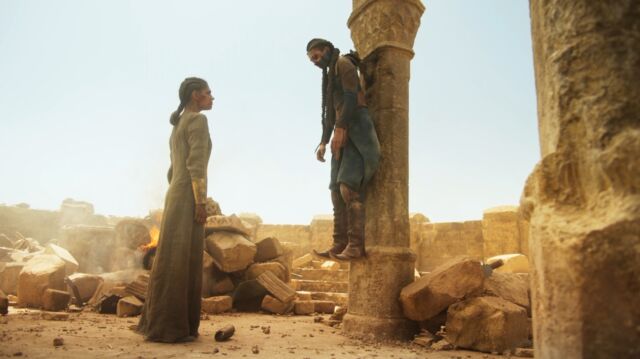
Definitely agree with Elayne being underutilized—though as you say, healing Rand was a nice way to facilitate an introduction. The only problem is that Elayne is crap at healing. Don't expect her patch job to hold very long or very well. Moiraine will likely have harsh words for her later.
Okay, so—I greatly enjoyed almost everything about this episode, but there were two major book events we didn't get. The first was the blademaster fight with High Lord Turak, which in the books is used to shove Rand further along the path of getting used to channeling and embracing the One Power. However, given the Raiders of the Lost Ark fashion in which Rand sidesteps the fight, I just can't be mad. I literally laughed out loud.
But the other thing we're missing is much harder to overlook: the oft-teased proclamation of the Dragon in the sky above Falme. In the books, this is a giant epic flaming sword fight between Ishamael and Rand, projected like a Pink Floyd laser light show onto the clouds above Falme. In the show, Moiraine does a Final Fantasy VII-style summoning and calls up a large fiery dragon, which curls around the tower and makes some dragon noises and disappears.
I'm disappointed. It's fine, I guess, but it's not what I was hoping for.

There is also a lot of hand-waviness going on here with respect to how strong Moiraine is, since she can't take on Lanfear directly but can single-handedly sink an entire Seanchan fleet and have enough leftover to make a big fire dragon besides.
The show downplaying Rand's sword skills and amping up his channeling skill is the same kind of early power-up that Mat is getting (to borrow your phrasing). You get all the way to book four or five before you see Rand doing anything that resembles enthusiastic or competent channeling, but show Rand is already casually raining fire bullets down on his enemies.
The only one of our three boys who is still kind of muddling through with respect to his new Chosen One Abilities is Perrin, who gets very mad when his wolf friend goes down in battle but still hasn't manifested much by way of superpowers.
If season three is being set up as an adaptation of book three and/or four, we'll hopefully see Perrin get a little more attention, since both books are Perrin-heavy.

Oh, and speaking of people to keep an eye on—book readers know this, but non-readers may not: shortly before Mat sounds the Horn, during the little reunion on the streets of Falme between our main characters, Perrin makes it a point to give a quick hug to the other Shienaran present—a gentleman he calls Masema (Arnas Fedaravicius). We then see Masema again near the end, staring at the Dragon atop the tower.
Remember Masema. He was introduced at the end of season one, and this will not be the last time we see him.
Alright, we're down to the last little bits here. Season two ends with Lanfear encountering Moghedien, spinner of webs and plots. She seems… creepy.
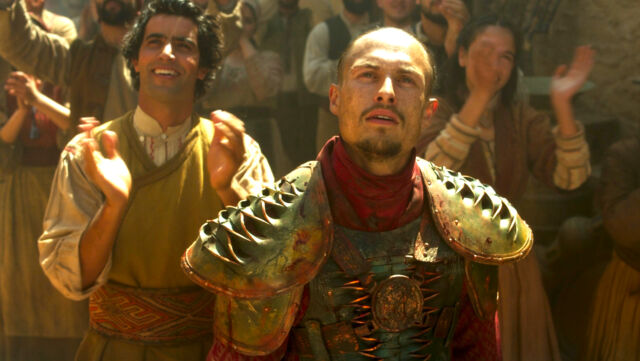
I have guesses about who's left, but am I missing other dropped hints?
Out of the original book list, there are eight remaining Forsaken that have yet to appear or be mentioned in the show. If "the boys" can be taken to mean that all the remaining unnamed Forsaken are male, we can drop the two remaining Forsaken who are female. That leaves us with six candidates for our last three spots: Aginor, Asmodean, Balthamel, Be'lal, Demandred, and Rahvin.
We can dump Aginor and Balthamel immediately, as they were killed in the book version of The Eye of the World and didn't appear in the show. I'd also propose we can drop Demandred, given what he's doing in the books and how it works out—I think the show is going to nix his entire plot.
And that neatly leaves us with three dudes left, and my picks for the remaining Forsaken: Rahvin, Asmodean, and Be'lal. And out of those three, my guess is that we meet Asmodean first, in a manner similar to how he shows up in the books.
What do you think?
Of the men who are left, Rahvin seems like the most obvious choice, since his activities also impact Elayne pretty directly.
I agree Aginor and Balthamel can be discounted. They are part of a group of three or four Nothing Forsaken who exist mostly as canon fodder. And it does seem like Demandred is pretty far away from the action the show is focusing on, though this read does assume that the show will stick with the books' version of events, and the show has been hard to predict on that score.
I'd tend to include Be'lal among the Nothing Forsaken, too, since "ruler of [redacted city] who gets smoked by Rand at their first encounter" doesn't leave the show much personality to work with. Maybe cannon fodder is what the show needs, though, especially if we're still doing the Callandor storyline next year.
I do wonder if "the boys" thing isn't a red herring; Lanfear is disparaging the Forsaken she mentions in that conversation, and maybe there's one woman in the group she respects enough not to insult. Eight Forsaken also gives the show a chance to harp on some thematic One Power symmetry (also: casting symmetry!) by keeping four men and four women (remember, there are only two genders in the world of The Wheel of Time, and the books' only arguably trans character was basically created by the Dark One as a joke).
Anyway, I think my list is Rahvin, Be'lal, and the sadistic Semirhage. But you're the most sure about seeing the character I think we're least likely to see, so clearly there's lots of room for interpretation here.

And so, dear readers, we arrive at the end of our time together—but fear not, because we'll be back here doing this again for season three. Will Perrin come to terms with the wolves? Will Egwene be able to deal with her trauma? Will Mat avoid accidentally poking anyone with his evil toxic dagger-on-a-stick? Will Nynaeve ever figure out how the hell to channel properly? And what will the fallout be of the Dragon Reborn's public proclamation at Falme? How will Randland react, knowing that the Dragon is foretold to save the world—but also to break it anew?
We know the book answers to these questions, but folks, we are heading into uncharted territory with our Two Rivers TV show crew and their rapidly expanding list of friends. Unexpected things no doubt await us in season three.
Any final thoughts, Andrew?

Promoted Comments